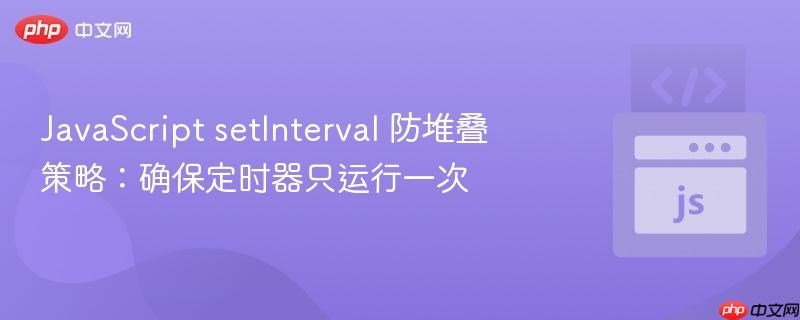
在javascript中,setinterval函数用于以指定的时间间隔重复执行一个函数。然而,当一个包含setinterval的启动函数(例如,一个类中的start()方法)被多次调用时,如果没有适当的管理机制,就会出现定时器堆叠的问题。
例如,考虑一个粒子生成器类ParticleGenerator,其start()方法负责启动粒子生成定时器,stop()方法负责停止它。如果start()方法被调用了两次,每次调用都会创建一个新的setInterval实例。此时,this.spawnManager属性将只存储最后一次setInterval调用返回的ID。当调用stop()方法时,clearInterval(this.spawnManager)只会清除最新的定时器,而之前创建的定时器将继续在后台运行,导致资源浪费、逻辑混乱,甚至可能引发性能问题。
原始代码示例中存在的问题:
class ParticleGenerator {
constructor(/* ... */) {
// ... 其他属性初始化
this.spawning = false;
this.particlesPerSpawn = particlesPerSpawn;
// 缺少对 spawnManager 的初始化
}
start() {
// 如果 start() 被多次调用,这里会创建多个 setInterval
this.spawnManager = setInterval(() => {
// 生成粒子的逻辑
}, this.spawnRate);
}
stop() {
// 只能停止最后一次 start() 调用创建的定时器
clearInterval(this.spawnManager);
}
}为了解决setInterval堆叠的问题,核心思想是在每次尝试启动新的定时器之前,先检查是否已经存在一个正在运行的定时器。如果存在,则先将其清除,然后再创建新的定时器。这确保了在任何给定时间,只有一个setInterval实例处于活动状态。
具体实现步骤如下:
立即学习“Java免费学习笔记(深入)”;
首先,在构造函数中初始化this.spawnManager:
class ParticleGenerator {
constructor(pgPhyEngine, x, y, width, height, particleSizeRange = {
min: 3,
max: 10
}, spawnRate = 100, particlesPerSpawn = 1, velXRange = {
min: -15,
max: 15
}, velYRange = {
min: -15,
max: 15
}, particleColorsArray = ["#ff8000", "#808080"]) {
this.parent = pgPhyEngine;
this.x = x;
this.y = y;
this.width = width;
this.height = height;
this.particleSizeRange = particleSizeRange;
this.velXRange = velXRange;
this.velYRange = velYRange;
this.particleColors = particleColorsArray;
this.spawnRate = spawnRate;
this.spawning = false;
this.particlesPerSpawn = particlesPerSpawn;
this.spawnManager = null; // 初始化为 null
}
// ... (其他方法)
}然后,修改start()方法,加入清除逻辑:
class ParticleGenerator {
// ... (构造函数及其他属性)
start() {
// 在启动新定时器之前,检查是否已有定时器在运行
if (this.spawnManager !== null) { // 或者简写为 if (this.spawnManager)
this.stop(); // 如果有,先停止它
}
this.spawnManager = setInterval(() => {
for (var i = 0; i < this.particlesPerSpawn; i++) {
this.parent.createParticle((this.x - this.width / 2) + (random(0, this.width)), (this.y - this.height / 2) + (random(0, this.height)), random(this.particleSizeRange.min, this.particleSizeRange.max), pickRandomItemFromArray(this.particleColors), true, random(this.velXRange.min, this.velXRange.max), random(this.velYRange.min, this.velYRange.max));
}
}, this.spawnRate);
}
stop() {
clearInterval(this.spawnManager);
this.spawnManager = null; // 清除后将 ID 设回 null,表示没有定时器运行
}
}注意事项:
以下是应用了上述解决方案的完整ParticleGenerator类:
// 假设 random 和 pickRandomItemFromArray 是全局可用的辅助函数
function random(min, max) {
return Math.random() * (max - min) + min;
}
function pickRandomItemFromArray(arr) {
return arr[Math.floor(Math.random() * arr.length)];
}
class ParticleGenerator {
constructor(pgPhyEngine, x, y, width, height, particleSizeRange = {
min: 3,
max: 10
}, spawnRate = 100, particlesPerSpawn = 1, velXRange = {
min: -15,
max: 15
}, velYRange = {
min: -15,
max: 15
}, particleColorsArray = ["#ff8000", "#808080"]) {
this.parent = pgPhyEngine; // 假设 pgPhyEngine 有 createParticle 方法
this.x = x;
this.y = y;
this.width = width;
this.height = height;
this.particleSizeRange = particleSizeRange;
this.velXRange = velXRange;
this.velYRange = velYRange;
this.particleColors = particleColorsArray;
this.spawnRate = spawnRate;
this.spawning = false; // 此属性可能不再需要,因为 spawnManager 可以作为状态指示器
this.particlesPerSpawn = particlesPerSpawn;
this.spawnManager = null; // 初始化定时器ID
}
/**
* 启动粒子生成定时器。
* 如果定时器已在运行,则会先停止现有定时器再启动新的。
*/
start() {
if (this.spawnManager) { // 检查是否已有定时器在运行
this.stop(); // 如果有,先停止它
}
this.spawnManager = setInterval(() => {
for (let i = 0; i < this.particlesPerSpawn; i++) {
const particleX = (this.x - this.width / 2) + (random(0, this.width));
const particleY = (this.y - this.height / 2) + (random(0, this.height));
const particleSize = random(this.particleSizeRange.min, this.particleSizeRange.max);
const particleColor = pickRandomItemFromArray(this.particleColors);
const velX = random(this.velXRange.min, this.velXRange.max);
const velY = random(this.velYRange.min, this.velYRange.max);
// 假设 this.parent.createParticle 接受这些参数
this.parent.createParticle(particleX, particleY, particleSize, particleColor, true, velX, velY);
}
}, this.spawnRate);
console.log(`Particle generator started with ID: ${this.spawnManager}`);
}
/**
* 停止粒子生成定时器。
* 如果没有定时器在运行,此操作无效果。
*/
stop() {
if (this.spawnManager) { // 仅当有定时器ID时才清除
clearInterval(this.spawnManager);
console.log(`Particle generator with ID ${this.spawnManager} stopped.`);
this.spawnManager = null; // 清除后将 ID 设回 null
}
}
// 示例用法 (需要一个 pgPhyEngine 实例)
// const engine = {
// createParticle: (...args) => console.log("Creating particle:", args)
// };
// const generator = new ParticleGenerator(engine, 0, 0, 100, 100);
// generator.start(); // 启动第一个定时器
// setTimeout(() => generator.start(), 2000); // 2秒后再次调用 start,会先停止第一个再启动新的
// setTimeout(() => generator.stop(), 5000); // 5秒后停止定时器
}通过在start()方法中引入一个简单的条件判断和清除逻辑,我们成功地解决了setInterval因重复调用而导致的堆叠问题。这种模式不仅适用于setInterval,也适用于其他需要确保单一实例运行的异步操作(如setTimeout)。它是一种健壮的设计模式,能够有效管理定时器生命周期,防止资源泄漏,并确保应用程序的逻辑行为符合预期。在开发涉及周期性任务的JavaScript应用时,务必考虑并采纳这种防堆叠策略。
以上就是JavaScript setInterval 防堆叠策略:确保定时器只运行一次的详细内容,更多请关注php中文网其它相关文章!

每个人都需要一台速度更快、更稳定的 PC。随着时间的推移,垃圾文件、旧注册表数据和不必要的后台进程会占用资源并降低性能。幸运的是,许多工具可以让 Windows 保持平稳运行。

Copyright 2014-2025 https://www.php.cn/ All Rights Reserved | php.cn | 湘ICP备2023035733号